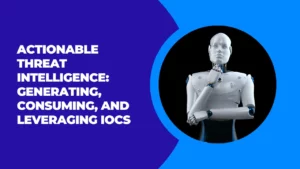Physical Address
304 North Cardinal St.
Dorchester Center, MA 02124
Physical Address
304 North Cardinal St.
Dorchester Center, MA 02124

If you work in cybersecurity, then you know how important it is to stay ahead of threats. Threat intelligence is what helps us achieve this goal. It is the practice of gathering information about potential cyber attacks and using that information to protect our systems and networks.
In this blog post, we will discuss actionable threat intelligence for 2024. We will cover topics such as the importance of threat intelligence, the cyber threat intelligence cycle, and different types of threat intelligence.
We will also delve into how machine learning is enhancing threat intelligence and provide use cases for actionable threat intelligence. Lastly, we will explore how we can stay ahead of threats in 2024 by generating, consuming, and leveraging IOCs.

Gain insights into potential cyber threats and vulnerabilities, and identify threat actors and their tactics, techniques, and procedures (TTPs). Leverage threat intelligence to enhance your organization’s security posture and stay informed about emerging cyber threats and attack vectors.
Enhance proactive risk analysis and decision-making processes. Dissemination of threat intelligence is crucial for organizations to effectively utilize CTI and stay one step ahead of attackers.
By gathering and analyzing data from disparate sources, such as white papers, blogs, and cyber security experts, organizations can obtain strategic and tactical threat intelligence to mitigate risks.
Detecting and preventing cyber attacks before they cause significant damage is the critical role of threat intelligence in cybersecurity. It enables real-time monitoring and response to potential threats, improving incident response capabilities and shortening response times.
Threat intelligence also enhances the effectiveness of security controls and measures, providing valuable insights to stakeholders and decision-makers. By disseminating intelligence gathered from various sources, organizations can stay proactive in combating cyber threats.
Turn threat intelligence into proactive security measures and mitigate risks by identifying and addressing potential threats. Stay ahead of adversaries with timely and relevant threat data, improving security operations through automation and integration.
Enhance overall cyber resilience, ensuring organizations can effectively respond to emerging threat landscapes. By leveraging actionable threat intelligence, organizations can enhance their security posture and proactively protect against evolving cyber threats.
Organizations of all sizes and industries, security teams and analysts, security operations centers (SOCs), boards of directors and decision-makers, as well as cybersecurity experts and professionals can benefit from actionable threat intelligence to detect and respond to potential threats, enhance capabilities, make strategic decisions, and stay updated on the latest threats and trends.

The cyber threat intelligence cycle in 2024 encompasses several key stages. Organizational requirements and goals drive the planning and direction of intelligence efforts. Intelligence is collected from diverse data sources and channels, such as white papers and disparate sources.
It is then processed and analyzed to extract relevant insights. These actionable findings are disseminated to stakeholders, including cyber security experts and organizations. Feedback received helps in the continuous improvement of the intelligence lifecycle.
Define intelligence requirements based on organizational goals and priorities. Identify potential threats and adversaries that pose the highest risk. Establish a clear roadmap and strategy for gathering and analyzing intelligence.
Align intelligence efforts with other security and business functions. This ensures efficient dissemination of CTI to relevant stakeholders, allowing organizations to make proactive and informed decisions. By leveraging both tactical and strategic threat intelligence, organizations can stay ahead of attackers and mitigate risks effectively.
Effective planning and direction in threat intelligence is crucial for organizations of all sizes and industries to enhance their cyber resilience.
To effectively gather threat intelligence, it is essential to gather data from diverse sources such as news, social media, and technical threat intelligence. Monitoring the dark web can uncover potential threats and indicators of compromise (IOCs).
Automating the collection process using threat intelligence tools helps streamline the process. Incorporating intelligence feeds and data sources from trusted providers enhances the quality and reliability of the collected information.
Continuous updates and expansion of intelligence collection capabilities ensure up-to-date and comprehensive threat intelligence.
To effectively process and analyze threat intelligence, cyber security experts utilize various techniques. They analyze collected intelligence to identify patterns and trends, extracting meaningful insights from raw data for actionable intelligence.
Machine learning and analytics are applied to enhance threat detection capabilities. Validating and verifying intelligence helps minimize false positives and negatives. Collaboration between teams is crucial for combining technical and operational threat intelligence.
This ensures a comprehensive analysis that enables organizations to proactively defend against attackers.
Share relevant and actionable intelligence with stakeholders in a timely manner, catering to their specific needs. Promote knowledge sharing and collaboration among security personnel to enhance the intelligence cycle.
Gather feedback and insights from stakeholders to continually improve the dissemination process. Maintain effective communication channels for efficient dissemination and reception of intelligence. By following these practices, organizations can ensure that their threat intelligence efforts are effective and impactful.

Understanding the different types of threat intelligence, including tactical, strategic, and operational, is crucial in modern cybersecurity. By leveraging technical threat intelligence, organizations can gain insights into specific attacks and vulnerabilities.
Open-source intelligence (OSINT) allows for gathering information from publicly available sources, while commercial vendors and threat intelligence platforms provide additional valuable intelligence.
Staying updated on new threat indicators and red flags helps organizations anticipate future attacks. Embracing these different types of threat intelligence enhances the overall security posture.
Identifying potential threats through real-time monitoring is essential in tactical threat intelligence. Analyzing and correlating data from various sources enables the uncovering of attack vectors.
Threat intelligence tools gather and analyze threat indicators while staying informed about the latest Tactics, Techniques, and Procedures (TTPs) used by threat actors. Leveraging actionable threat intelligence allows for proactive defense against cyber attacks.
To effectively implement operational threat intelligence, organizations must collect and analyze threat data feeds from various sources. By utilizing automation, security teams can process large volumes of raw data and identify potential threats.
Disseminating relevant intelligence to stakeholders ensures that the right information reaches the right people at the right time. Collaboration with other organizations enhances defenses by sharing valuable insights. Continuously updating intelligence requirements allows organizations to stay ahead of evolving threats.
Conducting extensive research and analysis on emerging cyber threats, strategic threat intelligence helps organizations stay ahead of attackers.
By monitoring the dark web and underground forums for indicators of compromise, cyber security experts can provide tailored intelligence reports to decision-makers.
Assessing the potential impact of new vulnerabilities and exploiting trends, they develop long-term strategies to mitigate future attacks. This dissemination of actionable threat intelligence allows organizations to proactively defend against evolving threats.
Machine learning is revolutionizing threat intelligence by leveraging its ability to analyze vast amounts of security data. Through automated systems, it can detect and respond to threats in real-time, while also prioritizing alerts and reducing false positives.
Continuously learning from new data, machine learning enhances the accuracy of threat detection, empowering security personnel with data-driven decision-making.
IOCs, or Indicators of Compromise, can be generated by analyzing malware samples and cyber threat intelligence. Sharing and consuming IOCs with other organizations enhances collective defense against attackers.
These IOCs can then be incorporated into security controls like SIEM systems to identify and respond to potential threats in real time. Staying updated on the latest IOCs through threat intelligence feeds and reliable news sources ensures organizations are equipped to tackle evolving cyber threats.
Detect and mitigate phishing attacks by analyzing email headers and content for suspicious indicators. Identify and block malicious IP addresses associated with known threat actors.
Utilize actionable threat intelligence to improve security incident response and reduce dwell time. Enhance security awareness training by incorporating real-world examples and specific attack techniques. Conduct threat hunting exercises using tactical intelligence to proactively identify potential threats.
To stay ahead of threats in 2024, adopt a proactive approach by utilizing actionable threat intelligence. Continuously monitor and assess new attack vectors to adapt defenses accordingly.
Foster collaboration with industry peers and information sharing with threat intelligence communities. Invest in advanced tools and stay updated on cybersecurity trends from reputable sources.
In conclusion, actionable threat intelligence plays a critical role in today’s cybersecurity landscape. It helps organizations detect and respond to threats effectively, ultimately protecting their valuable data and resources.
By embracing different types of threat intelligence, such as tactical, operational, and strategic, organizations can gain a comprehensive understanding of potential threats and tailor their security measures accordingly.
Machine learning is also enhancing threat intelligence by automating analysis and detection processes, enabling faster and more accurate identification of malicious activities.
Generating, consuming, and leveraging indicators of compromise (IOCs) is a crucial aspect of utilizing threat intelligence effectively. It allows organizations to proactively identify and mitigate threats before they cause significant damage.
As we move forward in 2024, staying ahead of threats will require continuous monitoring, collaboration, and the adoption of advanced technologies to strengthen our cybersecurity defenses.